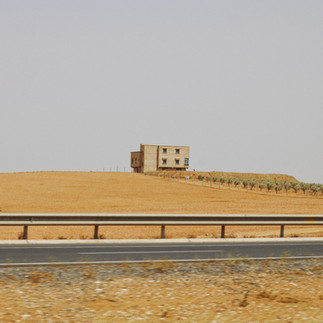Salah-Eddine Mouslim working on the series Georganic and Observing The Ordinary
- Uncommon Studio
- Nov 26, 2024
- 4 min read
Updated: Aug 5
Exploring minimalism with Salah-Eddine
Salah-Eddine Mouslim (b. 2002) is a photographer and emerging visual artist from Oulad Teima, Morocco, currently based in Marrakech. His passion for photography began with his father’s point-and-shoot camera, capturing simple moments during summer vacations in his father's hometown and everyday scenes of family life. His work explores themes of new topographics, mundanity, isolation, and urbanism, drawing inspiration from the quiet rhythms and empty landscapes of his hometown. Through his photography, Salah-Eddine seeks a neutral perspective, uncovering the balance between ordinary sceneries and their extraordinary representations.
Salah exhibited his work for the first time at the Prix Mustaqbal 2024 by Artorium Foundation TGCC and the Yasalam Exhibition as part of the 1-54 Art Fair circuit at L’Blassa Art Space.
How did you get started in photography? Tell us about your earliest memories with photography or an incident that led you to pick up the camera?
I think it happened quite naturally. My dad was really passionate about photography and had several types of cameras. I remember my first interaction with a camera was with his video camcorder—I used it to film my family during one of my childhood birthday parties. After that, my connection to photography started growing, especially during summer vacations when we would take walks with the camera in my father’s hometown. I think that’s also why I developed such an attachment to landscape photography. Since then, the camera has unconsciously become an essential tool for documenting my life.
What led to you working on the series or “Georganic”?
Georgranic started as an exercise to challenge myself. At the time, I realized my work was mainly focused on bright colors and wide landscapes. For this series, I limited myself to black and white and focused on two main elements: organic and geometric shapes and materials I encountered during my photo walks. The goal was to create a collection that explored the contrasts and perhaps even the similarities between these two types of shapes, while still connecting to my ongoing search for meaning in my daily, ordinary observations.
Tell us about your favorite place to shoot in Morocco.

I honestly don’t think there’s a specific place I prefer to photograph, but I’d say I’m drawn to places that are generally empty and calm, especially around mountainous areas. I think this preference comes from my upbringing in a small town surrounded by vast, empty fields, mountains, and a sparse population.
Are there particular photographers, artists, or Moroccan traditions that inspire your work?

Being introduced to the photos Bruno Barbey took in Morocco really expanded the way I see composition and color, encouraging me to experiment more with both. Also, aside from using my father’s cameras, our family would often gather to look at his archive of printed photos from his teenage years—pictures of his hometown, my mom, and my brother and I as kids. Those moments had a deeply intimate impact on how I approach photography today.
What inspires you to keep going even amid so many voices? What do you want to convey with your photography?
“Introspection” is the term that always gives meaning to my work. When I pause to reflect on it, I realize that whenever I take photos outside of my hometown, it feels like yet another attempt to find my old home. Home is a concept I’ve always struggled to define. I know it’s tied to the people we love, those who ground us, but it’s also shaped by the spaces we’ve lived in and interacted with over time. Since I no longer live in my hometown, photography has become my way of expressing this deep attachment to space, to those familiar corners and forgotten streets. It’s a tool I use to capture the moments of my search for a new home, to document this quiet journey of seeking a place, a sense of belonging.
Can you share a particularly memorable experience from one of your photography projects?
During the 2020 lockdown, like everyone else, I struggled to find objects to photograph. But as we spent so much time on our house rooftop, I found myself taking countless photos of the rooftop walls. That simple act became an epiphany, sparking the beginning of the project Observing The Ordinary. Over time, this evolved into a desire to capture the basic elements that shape urban landscapes, as well as anything else that might be perceived as mundane but holds its own quiet significance.

How has your style evolved over time, and what aspects of minimalism are you exploring now?
I actually never really perceived my work as minimal, because for me, that’s just what I grew up with. I rarely encountered more maximal sceneries, so I didn’t view things in a binary way. To me, everything felt simply neutral. However, as my style evolves, I’m becoming more confident in exploring different landscape conditions. For example, I recently started taking more photos at night, something I hadn’t experimented with before. I’m also becoming more at ease with taking portraits, photographing in crowded places, and engaging in general social interactions.
Lastly, are there any new projects that you are working on currently?
Yes, the main project I'm working on is called "Cliché," and it explores the evolution of my relationship with palm trees. It begins with a lone palm tree I used to play around with my friends as a kid in my hometown, and then transitions to a more complex and controversial relationship with palm trees after I moved to Marrakech, a city famous for them.
Follow Salah-Eddine Mouslim






























Comments